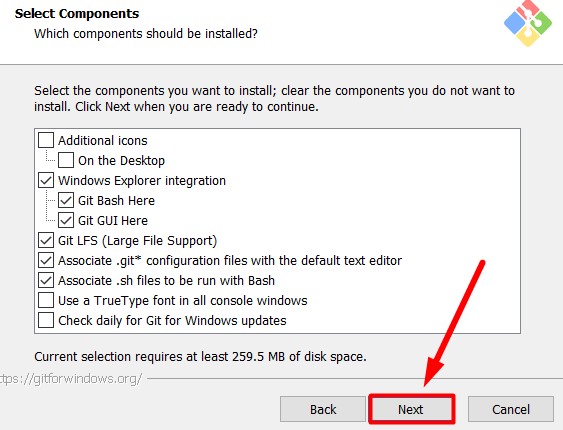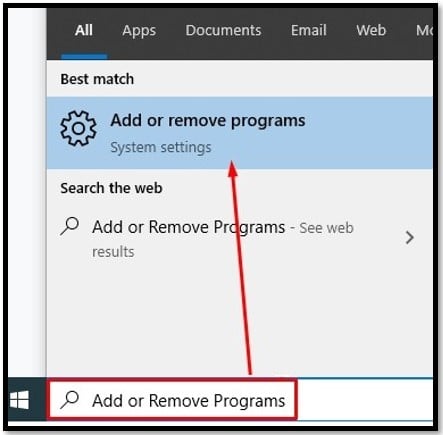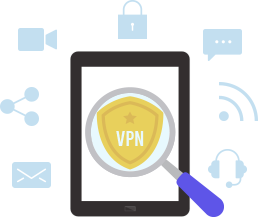Git is one of the most popular distributed version control systems (VCS) among developers. It was created by Linus Torvalds, the creator of the Linux kernel. Git excels at maintaining the history of the code and allowing multiple users to work on the file remotely without sabotaging each other. The software works with all major operating systems and many Integrated Development Environments (IDE).
Follow the steps below and download Git for free.
How to Download Git to your Computer for Free
- Click on the download button located on the sidebar, and the official Git download page will open in a new tab.
- Choose the operating system you’re using, and the exe file will automatically download to your computer.
- Open the file, and the installation wizard will open.
- To begin, you will have to accept the License Agreement.
- Choose which Git components you want to install. If you’re not sure which to include, use the default settings and click Next.
![git components]()
- You can adjust the name of the initial branch in new repositories or let Git decide. Then click Next.
- Determine how you want Git to use the command line. The first option is to use Git Bash only. The recommended option is to use Git from the command line and from third-party software. The final option is to use Git and optional Unix tools from the command prompt. Once you make your selection, click the Next button.
- Choose the HTTPS transport backend. The recommended choice is to use the OpenSSL library, but you can choose to use the native Windows Secure Channel library if you prefer. Then click Next.
- Git will complete the installation on your computer.
How to Uninstall Git from your Computer
If Git isn’t the right software for you, check out the free alternatives listed below.
You can uninstall it by following these simple steps:
- Type Add or Remove Programs in the Windows search bar and click Enter.
![Add or Remove Program]()
- Search for Git in the list of installed software and click on the Uninstall button.
- The Windows uninstallation wizard will completely remove Git and all its components from your computer.
Git Overview
Git is a popular Version Control System (VCS) tool for open-source developers since it makes it easy to track changes to the code. With so many people having access to the software, it can be difficult to know what changes were made and why, but with Git, you can see all this information clearly.
It is also helpful when working with a team, as it saves “Checkpoints” and tracks the team’s progress over an extended period.
While Git isn’t an easy tool for beginners, once you get the hang of it and learn the jargon, you’ll see its value in no time.
Git Features
- A distributed system allows you to work with people worldwide: The Git distributed system allows multiple users to work on the code or project at the same time, without affecting the other users. When one team member completes their code, they push the changes in the repository, which updates it as a local copy, and doesn’t interfere with the versions other users are working on. When all the users are finished working, they can activate a global update that uploads the changes saved on local files onto the main file.
- Data Loss Prevention: A common error that occurs with other programs is Data Loss or Data Disconnect. To prevent this, Git takes a snapshot of every update and mirrors it on other repositories. Then, if the central server malfunctions, a copy of the latest file can still be retrieved from the users who have downloaded the latest snapshot of the project.
- Compatible with all Operating Systems and Major VCS: In addition to high-quality compatibility with Linux, PC, and macOS, Git repositories also work with other Version Control Systems like SVN and CVK. This makes it easy to switch a project over tp to Git without needing to copy their files.
- Use Branching to create your own version: The branching function in Git allows you to make changes to the code without affecting the original program. This is ideal for testing new features or code before you’re ready to update the previous version. Once the branch is ready for publication, you can easily merge the branch through a few basic Git commands or save it as a separate project, each with its own features.
Free Alternatives to Git
- Mercurial: While not as fast Git, Mercurial is still one of the best alternatives to Git. It is a distributed VCS with a modern command-line tool that is easy to learn. The history of a code can’t be changed, which is critical for most developers. Mercurial works well on all platforms and operating systems but really excels with WIndows, where it has excellent customer support.
- Bazaar: Bazaar is similar to Git and Mercurial, although it hasn’t had a major update in several years. The biggest advantage it has over the others is its “Bounded Branch” feature. This will check the remote repositories to ensure that all files are synced and updated before applying the branch update. It is a native Windows program but also works well with Linux and Mac.
FAQ
Is Git Free?
Git was developed after the popular BitKeeper tools removed its free license to provide developers with a free VCS. It is released under the GNU General Public License version 2.0, which is an open-source license. Follow the guide above to download GIT absolutely free.
Is Git secure?
All files, directories, version tags, codes, and more are secured with a hashing algorithm called SHA1. This prevents unauthorized users from changing the code or history, which would make it impossible to track. As long as you have the real source code history, you can check to ensure that the code wasn’t manipulated or infected with viruses or malware.
What is the difference between Git and GitHub?
Many people confuse Git with GitHub, and while they are related, they are very different. GitHub is a website for hosting open-source projects that use Git. While Git is a distributed VCS that tracks changes, as well as many other features, and helps developers create the actual software that will one day be available to download on GitHub.
Visit Git Website


